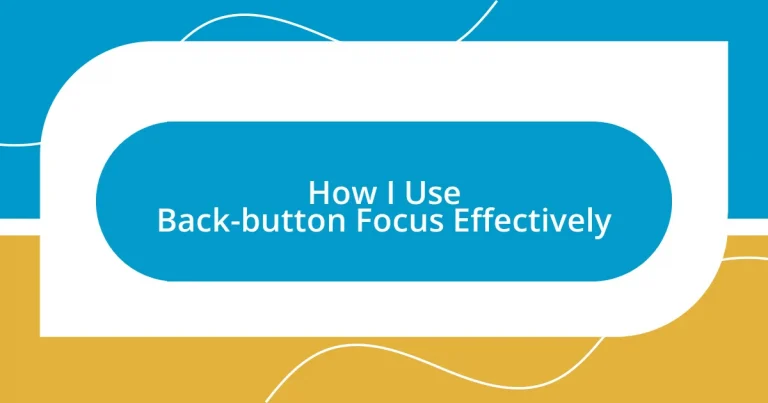Key takeaways:
- Back-button focus allows for independent focus control from shutter release, enhancing precision and creative control.
- Setting up your camera correctly, including customizing buttons and using continuous autofocus, is crucial for effective back-button focus usage.
- Integrating back-button focus with techniques like exposure compensation and burst mode can dramatically improve photography outcomes in dynamic situations.
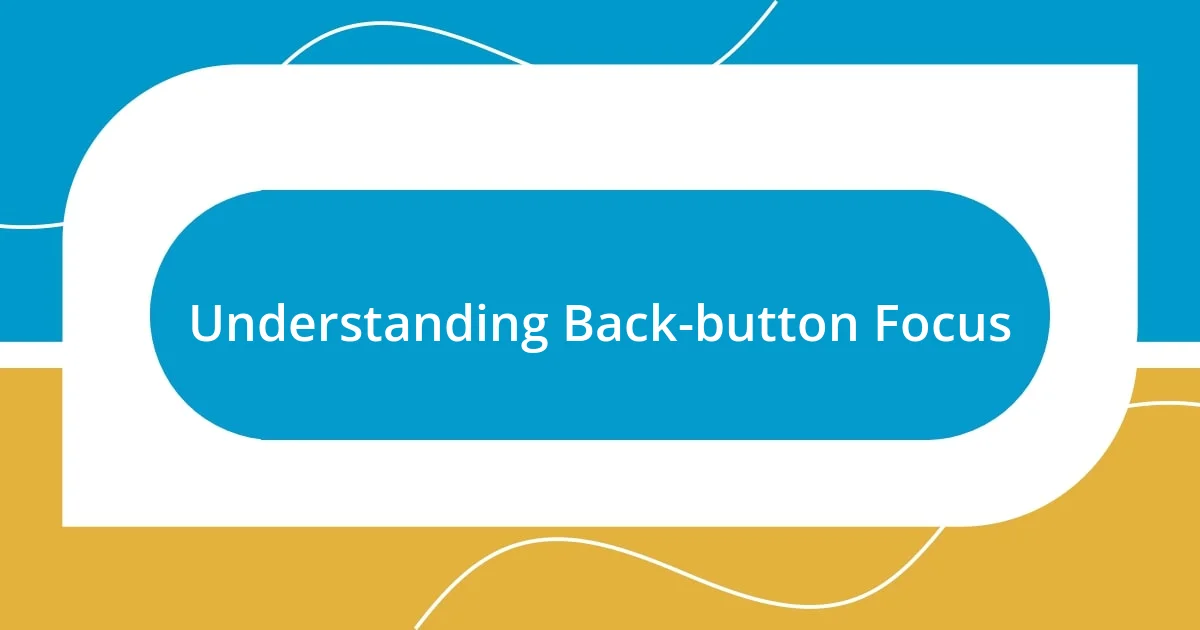
Understanding Back-button Focus
Back-button focus is a technique that allows photographers to separate the act of focusing from the shutter release. I remember the first time I tried it; it felt like unlocking a hidden power in my camera. Suddenly, I was able to focus on a subject without the fear of unintentionally taking a photo, giving me more creative control and confidence.
When you’re framing a shot, have you ever noticed how easy it is to lose the focus while adjusting your composition? That’s exactly why I gravitated toward back-button focus. With a dedicated button for focusing, I could recompose my shots without worrying about recalibrating the focus. It makes a world of difference, especially in dynamic scenarios like wildlife photography, where every second counts.
Incorporating back-button focus into my workflow also changed the way I viewed my subject. Instead of rushing to capture a moment, I could take a breath, focus on what truly mattered, and then click the shutter. The emotional weight of capturing a moment is heightened when you’re fully engaged, and this technique helps me do just that.
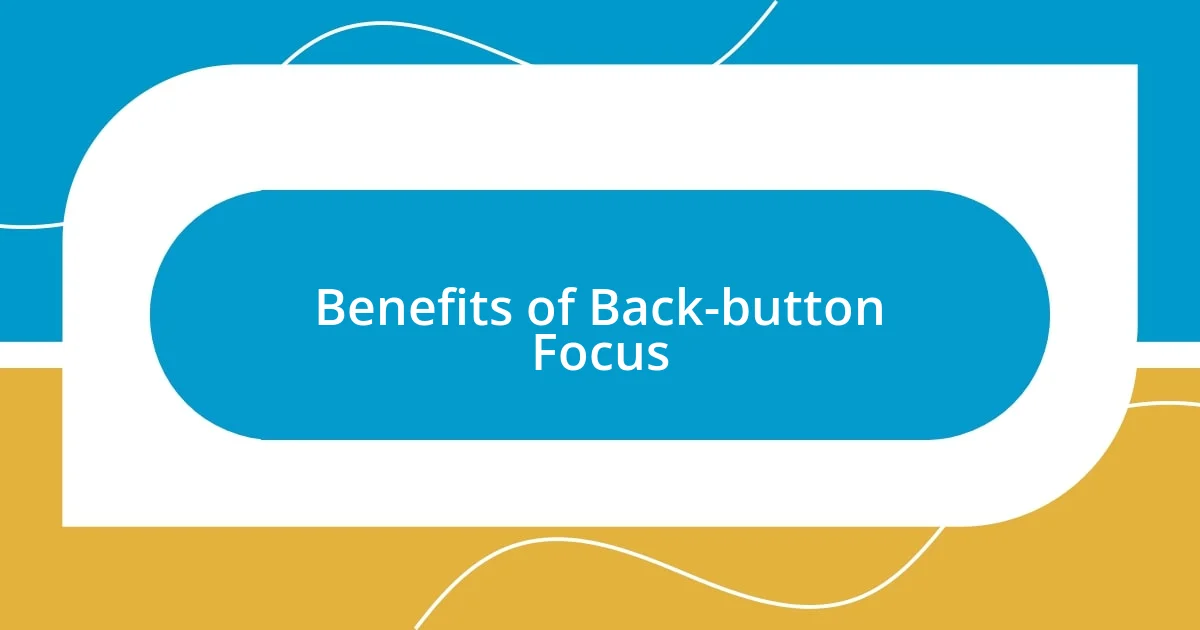
Benefits of Back-button Focus
Shifting to back-button focus truly transformed my photography experience. I can’t tell you how many times I missed the perfect shot while fiddling with my camera settings. Now, with separate focus control, I can anticipate a moment unfolding, lock in on the subject, and stay in the moment without that nagging hesitation. It’s like gaining an extra layer of freedom to create.
The benefits of using back-button focus are both practical and emotional. Here’s a quick rundown of what I’ve experienced:
- Enhanced Control: I can manage focus independently from shutter release, giving me the freedom to compose my shot intentionally.
- Increased Precision: I can maintain focus on moving subjects, ensuring sharp shots even in dynamic environments.
- Less Distraction: I’m not constantly worrying about refocusing, so I can immerse myself in the art of capturing the moment.
- Greater Flexibility: I can rapidly adjust my frame while keeping the focus locked, adapting to changing scenes without missing a beat.
This technique definitely uplifted my confidence as a photographer, allowing me to capture the essence of every scene much more effectively.
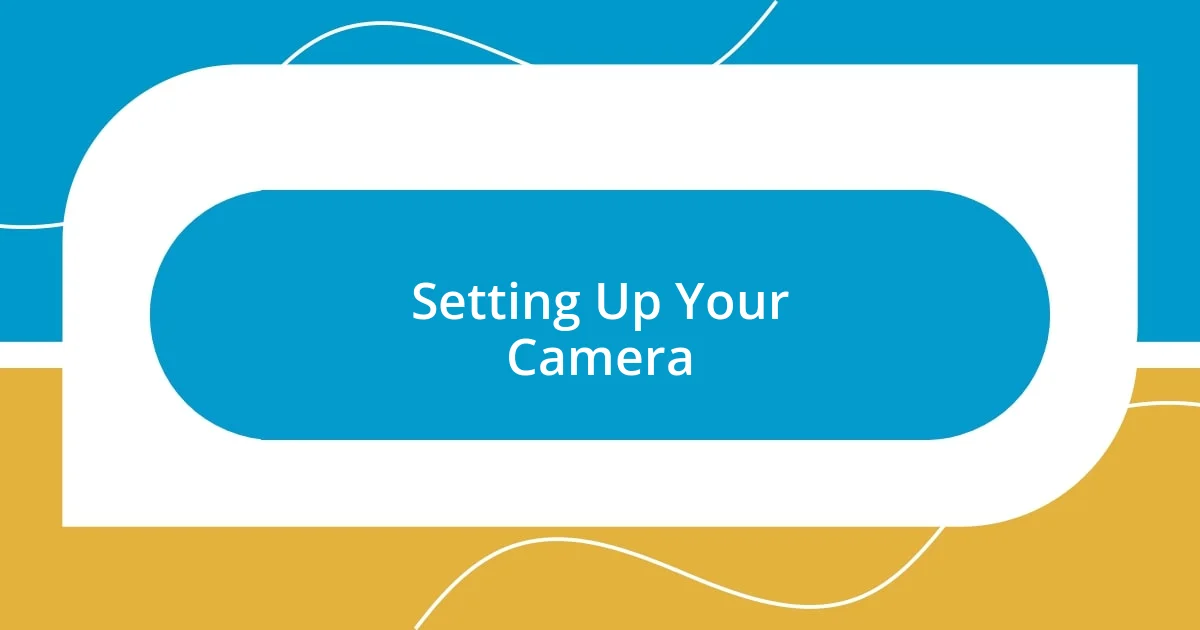
Setting Up Your Camera
Setting up your camera for back-button focus is crucial for maximizing its potential. First, you’ll want to locate your camera’s custom settings. It took me a bit of exploration to find the right menu option, but once I did, I felt a wave of relief. Assigning back-button focus allows you to free yourself from the traditional shutter button’s limitations, which can often lead to missed opportunities.
Next, it’s vital to select the appropriate focusing mode. For me, switching to continuous autofocus made a significant difference, especially when shooting sports or wildlife. I remember capturing a hawk in mid-flight; the ability to maintain focus while tracking its movement was exhilarating. Set your focus point accurately, so you’re ready to snap the moment with precision.
Finally, practice is essential. Spend some time just getting comfortable with the feel of the back-button. When I first made the switch, it felt a bit awkward, like trying to write with my non-dominant hand. However, now, it feels like second nature. It’s that little adjustment that has transformed my shooting style and made a remarkable impact on my images.
| Camera Settings | Description |
|---|---|
| Custom Button Assignment | Assign back-button focus to a custom button for easy access. |
| Focusing Mode | Choose continuous autofocus for moving subjects. |
| Focus Points | Use single or dynamic focus points per your shooting scenario. |
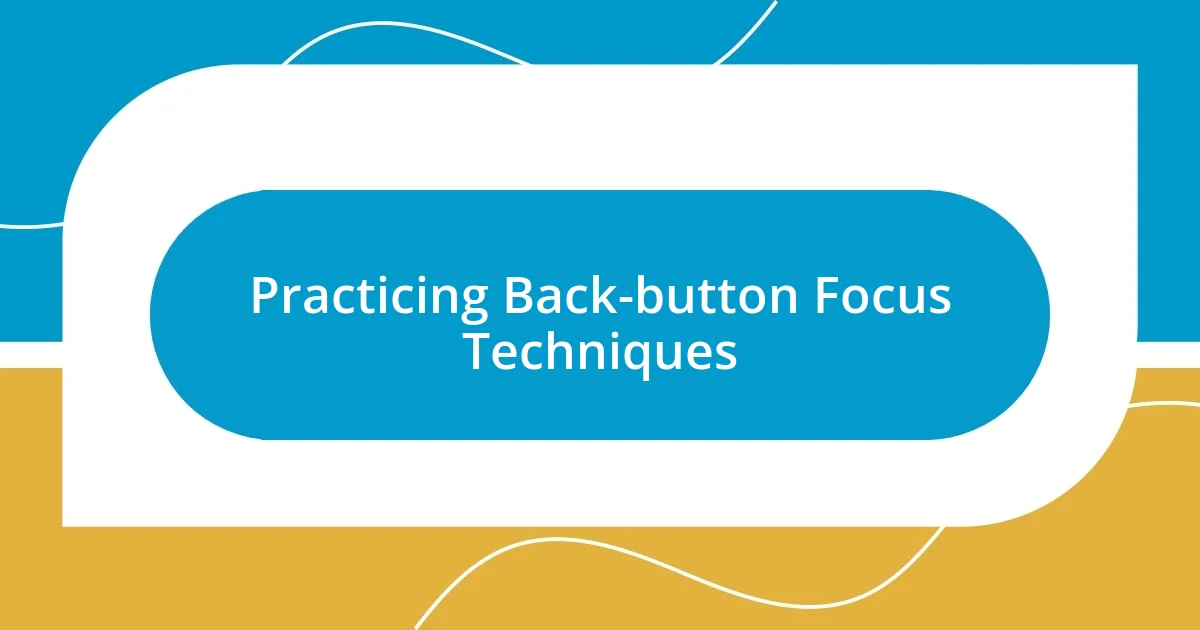
Practicing Back-button Focus Techniques
Practicing back-button focus techniques can be a game-changer, but it takes some time to get used to. When I first started, I found myself fumbling between buttons, often missing that decisive moment. It might feel awkward initially, but I encourage you to practice in various settings—like at a bustling market or during family gatherings—so you can truly appreciate the control you gain.
Once I became more comfortable with back-button focus, I realized how much more I could engage with my subjects. For example, while photographing my friend’s wedding, I was able to lock focus on the couple during their dance. It was a hectic moment, with guests moving around and everyone vying for the best view. But with my back-button focus technique set, I stayed calm and captured their joy perfectly. That’s when I truly felt the empowerment that this method offers.
To refine your skills, consider setting aside a specific day just for practice. I remember dedicating an afternoon to focus purely on technique. I shot everything from stationary objects to lively pets. Each shot became an opportunity to explore how focus and composition work in harmony, and by the end, I was not just more skilled but also more confident in my photographic abilities. Have you set aside focused practice time? It can truly enhance your understanding and execution.
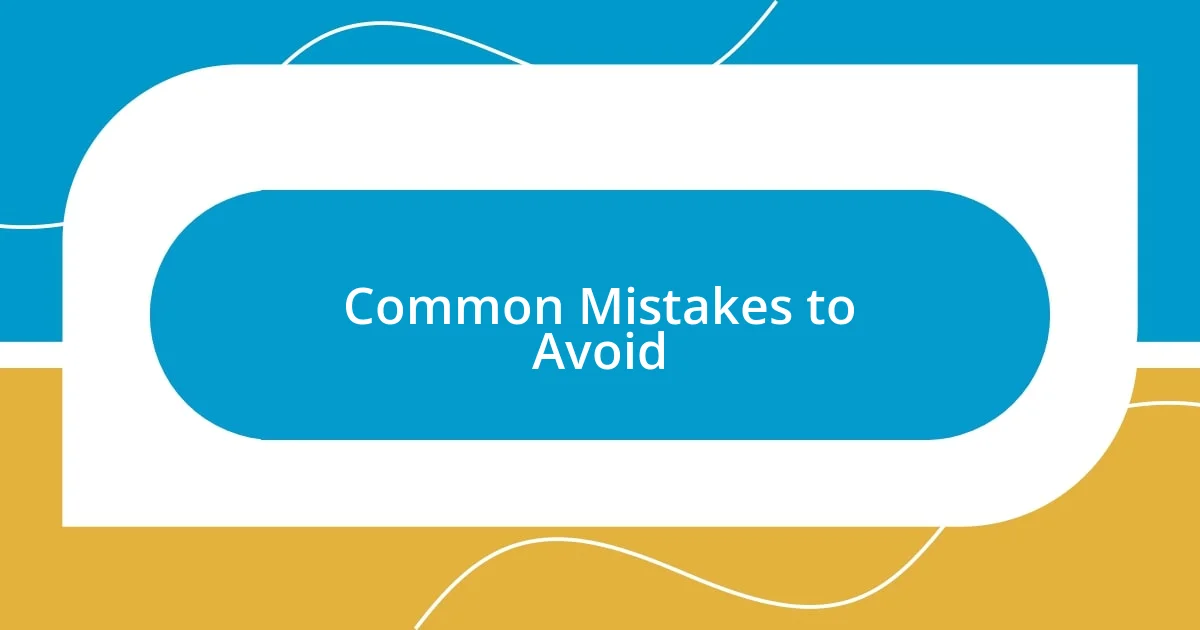
Common Mistakes to Avoid
When using back-button focus, one of the most common mistakes is not getting familiar with your camera’s button layout. I recall my early days of fumbling around trying to find the back button while a deer was grazing just a few feet away. It was frustrating! Taking the time to memorize button positions can prevent you from missing that perfect shot.
Another misstep is forgetting to update your focus area setting while switching between different shooting scenarios. I once shot a family portrait in a park and decided to quickly switch to taking candid shots of kids playing. Without adjusting my focus settings, I ended up with blurry images as they darted around. Always ensure your focus points are appropriate for your subject; it can save you from a world of disappointment later.
Additionally, many photographers neglect to practice regularly. Early in my journey, I thought a few trial runs would suffice. However, I quickly learned that the true magic of back-button focus reveals itself through consistent practice. Do you ever feel stuck in a routine? I recommend challenging yourself to shoot in unfamiliar environments to build confidence in using this technique. You’ll find that engaging deeply with the process not only enhances your skills but also reignites your passion for photography.
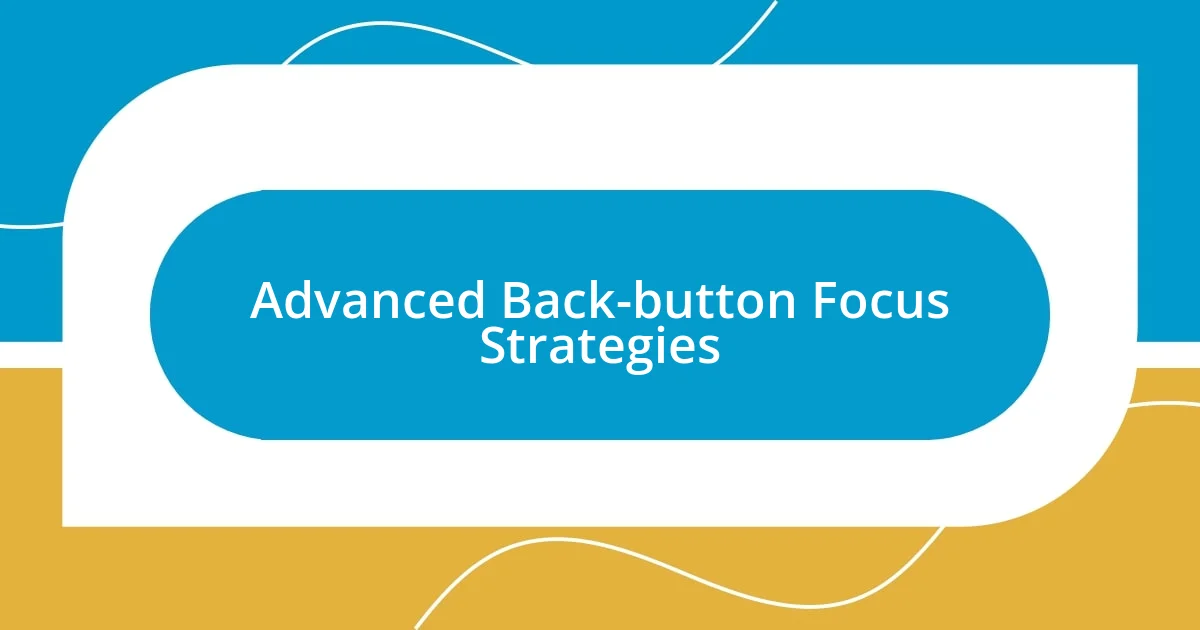
Advanced Back-button Focus Strategies
One advanced strategy I’ve found effective is adjusting the back-button focus for different situations. For instance, when I’m shooting sports or fast-moving subjects, I switch to continuous autofocus. This allows me to maintain focus even as my subject moves around dynamically. I still remember the thrill of capturing my niece’s soccer game, with kids running in every direction. Precision was key, and using continuous mode with back-button focus made all the difference in staying sharp!
Another technique I employ is to pre-focus before a significant moment occurs, especially in environments where action happens quickly—like at a street festival. I recall waiting in anticipation, my camera set for a colorful parade approaching. By using the back button to lock focus on a specific area, I created a stunning shot of a performer mid-leap. I challenge you to experiment with this; set up anticipation during your shoots, and see how much of a game-changer it can be.
Lastly, I encourage keeping a mental map of your composition as you lock focus. When I shot a flowing river with sunlight dancing across the surface, I focused on a rock in the foreground. Once I locked my focus, I could then recompose to bring the elements together harmoniously. How often do you think ahead about your composition? It’s a subtle yet powerful approach that elevates your photography, spotlighting creativity rooted in technicality.
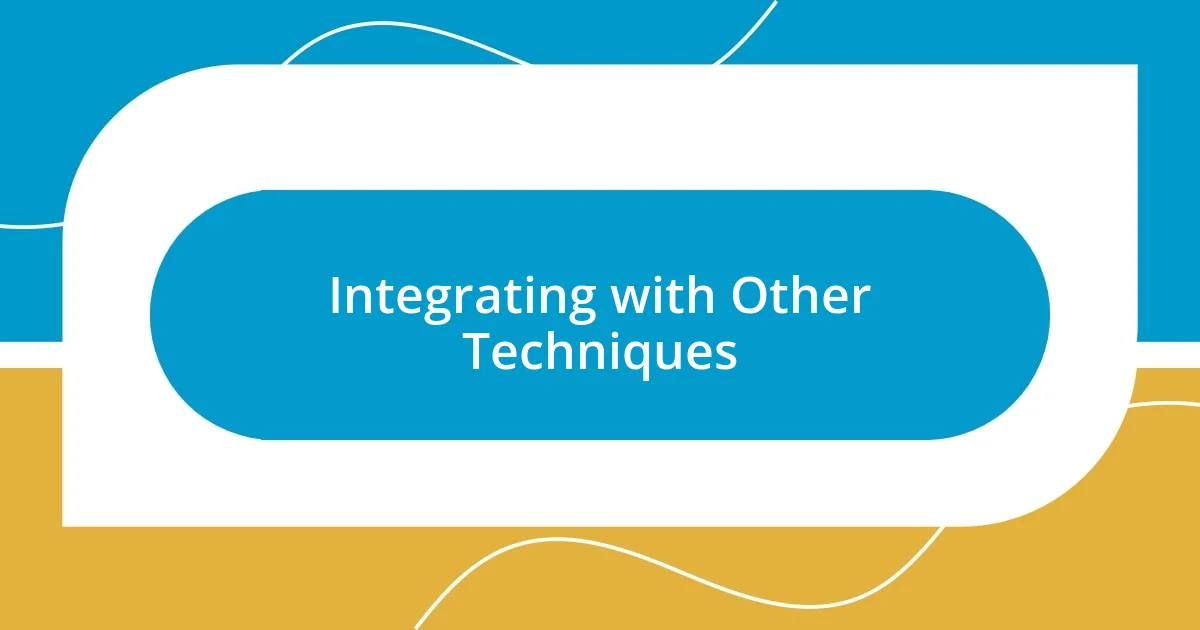
Integrating with Other Techniques
Integrating back-button focus with other techniques can elevate your photography game. For instance, pairing it with exposure compensation has proven invaluable during tricky lighting situations. I vividly remember shooting at sunset, where shifting light made it difficult to maintain both focus and exposure. Adjusting the exposure while using back-button focus allowed me to capture the beautiful tones of the sky without losing the sharp details of my subject. Have you ever faced similar challenges in dynamic light?
Additionally, combining back-button focus with burst mode is a strategy I rely on, especially during fast-paced events like weddings or sports. I distinctly recall a breathtaking moment at my friend’s wedding, where the couple shared their first dance. By holding the back button and firing off a series of shots, I was able to capture just the right expression as laughter and joy filled the air. The spontaneity that burst mode offers complements back-button focus perfectly. Have you tried using both together? It really opens up a world of possibilities for capturing fleeting moments.
Lastly, don’t underestimate the power of practicing different focusing techniques simultaneously. I remember a rainy day in the city, where I deliberately practiced back-button focus while also experimenting with manual focus. Switching between the two not only honed my skills but taught me adaptability. How often do you push your boundaries? The beauty of integrating techniques lies in discovering new ways to express your creative vision. Don’t be afraid to mix things up!












